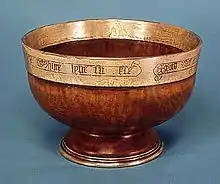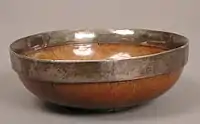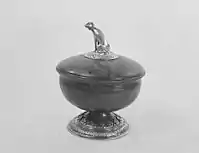.jpg.webp)
.jpg.webp)

A mazer is a special type of wooden drinking vessel, a wide cup or shallow bowl without handles, with a broad flat foot and a knob or boss in the centre of the inside, known technically as the print or boss. They vary from simple pieces all in wood to those ornamented with metalwork, often in silver or silver-gilt. They use dense impervious woods such as maple, beech and walnut wood.[3] They are a north European medieval tradition, mostly made from the 11th (or earlier) to the 16th centuries.[4]
Etymology
A form of the word mazer may have existed in Old English, but the evidence for this is slight. (The Oxford English Dictionary records speculation, for example, that the word occurs in the place-name Maserfield whose etymology is, however, uncertain.) The modern English word instead derived from Middle English mazer (and its variant spellings); this word was borrowed from Anglo-Norman, a dialect of Old French. Middle English or Anglo-Norman also gave the word to Welsh, as masarn ('maple, sycamore') and dysgl masarn ('mazer bowl').[5]
The Old French word mazre and its variants in turn derive from German, and it is clear that the word must have existed in Common Germanic, where it can be reconstructed as *masuraz. In the West Germanic languages it is found as Old Saxon masur ('swelling') and Old High German masar ('knot or swelling of a tree'), and later in the Middle Ages as Middle Dutch māser ('knot or swelling of a tree', especially a maple), Middle Low German māser ('curly-grained wood'), Middle High German maser ('curly-grained wood, excrescence on the maple and other trees, drinking cup made of curly-grained wood'). In the North Germanic languages it appears as Old Icelandic mǫsurr ('maple tree, veined wood') — including in the form mǫsurr skál ('maplewood vessel') — and Swedish masur ('curly-grained wood').[5]
The Germanic word *masuraz is thought to share its base with Old High German māsa ('spot, scar') and English measles, a base which may also have influenced the word maple. Whether this word has cognates elsewhere in the Indo-European languages is, however, uncertain.[5][6]
Description
The examples that have been preserved above ground are generally of the most expensive kind, with large mounts in silver, but some archaeological sites have produced quantities of plain wood mazers, which were no doubt the most common at the time. The wreck of the Mary Rose is one example of a group find, and the Nanteos Cup a single survival. They are typically between five and eleven inches in diameter.[3]
Ornamented types usually have a rim or "band" of precious metal, generally of silver or silver gilt; the foot and the print being also of metal.[7] There are examples with wooden covers, sometimes with a metal handle, such as the Bute Mazer or Flemish and German mazers in the British Museum. On the outside, but generally not the inside of the metal band there is often an inscription, religious, or convivial, and the print was also often decorated with a sculpted or engraved plare, and sometimes a gem.[8] The Bute Mazer is one of the most elaborate to survive, with a three-dimensional reclining lion rising from the base, and enamelled coats of arms in a circle around it. Saints, the religious monogram IHS, and animals, often no doubt with heraldic significance, are other common decorations of the boss. Many metal pieces that appear to be mazer bosses have been excavated.[9] An example from York Minster grants an indulgence of 40 days remission from Purgatory for all who drink from it.[10]
Later examples may be raised on a stem, perhaps copying the style of covered cups;[11] some from about 1550 onwards are effectively tazzas that are partly in wood. The later mazers sometimes had metal straps between the rim and the foot, as were added to the Bute Mazer. Examples continued to be produced after the main period ended in the 16th century, perhaps with a deliberate sense of traditionalism. Some modern woodturners and silversmiths have continued to produce examples, especially Omar Ramsden.[4]
Mounted examples are turned very finely, often from burr maple from the field maple. Both the wood and the vessels made of it were known as "mazer", so in contemporary accounts sometimes they are referred to as ciphis de mazer (drinking bowl of burr maple wood), and sometimes simply as a "mazer". The best mazers had silver or silver gilt rims added. Commonly prints were also added (a decorated disc in the base of the bowl), and occasionally, normally on later mazers, a silver or gilt foot was also added.
Use
The size of wooden mazers was restricted by the relatively small size of the trees that gave the best dense and grained wood. The addition of a metal band might double the capacity of a mazer.[12] Large ornamented mazers were probably passed around the table for toasts and the like, as some covered cups were, but more ordinary ones may have been regarded as personal within a group such as a household, ship or monastery, with the finer examples likely being reserved for the leading figures. Evidence from inventories suggests many mazers were given names.[10]
A record of customs at a monastic community in Durham records that each monk has his own mazer "edged with silver double gilt", but also an especially large one called the "Grace cup" was passed around the table after Grace. Another such, called the "Judas cup", was only ever used on Maundy Thursday.[13] Parish churches might be bequeathed mazers, and use them at "church ales" and other parish occasions.[14] Decorated mazers are often included and briefly described in wills and inventories. In 1395 John de Scardeburgh, rector of Tichmarsh, left twelve mazers, two more than were recorded in an inventory of the treasure of Henry IV of England four years later.[15] But monastic inventories could include dozens, including an exceptional 132 in an inventory of 1328 at Christ Church, Canterbury.[16]
In inventories, normally in medieval Latin, they are called by a variety of names (all the plural forms): "ciphi or cuppae de mazero or de murra, mazeri, cyphi murrae, mazerei, or hanaps de mazer (French).[17]
Surviving examples
Over 60 British medieval mazers are known to survive. Many of the English survivals were preserved in Oxbridge colleges, livery companies, hospitals and other institutions going back to the Middle Ages.[18] Relatively few have been passed down in wealthy families, though all such at the time would have owned them;[19] the Bute Mazer is an exception here.[20] A mazer still belonging to All Souls College, Oxford, but on loan to the Ashmolean Museum, was donated to the college in 1437, at the time of its foundation by Thomas Ballard, a landowner in Kent.[21]
Another example in a college is the late 14th-century Swan Mazer of Corpus Christi College, Cambridge, where a swan surmounts a thin column rising from the boss. If the mazer is filled too full, liquid runs down the column and out of the foot,[22] no doubt a trick played on unwary first-timers dining at the college.
Over the late Middle Ages there is a movement from deep bowls with narrow rims to shallower bowls and much wider rims.[3] In the 13th and 14th century rims tend to be simple and plain, only about 1 cm deep without lettering, 15th and 16th century rims are very characteristic with a very deep (3–4 cm moulded form) often with lettering. One exception to this rule is the mazer which Samuel Pepys drank from in 1660 (on display in the British Museum), the rim of this mazer is hallmarked 1507/8 but it is of the earlier simple form. A good display is at the Museum of Canterbury, where ten 13th and 14th century mazers are shown.[23]
A very fine example in the British Museum, from France or Flanders, probably in the early 15th century, has a very thin wooden bowl, and silver mountings of excellent quality, including enamels, but neither the cup nor the cover have metal on the rim, or ever seem to have done so. The cuir-bouilli travelling-case also survives.[24]
The Watson Mazer is the earliest in the sequence of Scottish standing mazers, featuring the coat of arms for David Watson of Saughton. Chemical analysis places it in the early 16th century.[25] It is constructed of a maplewood bowl with a silver-gilt band, resting on a silver stem and an inscribed trumpet-shaped foot. Today it is part of the Silver Treasury, level 5 of the Scotland Galleries in Edinburgh.[26]
 The "Robert Chalker Mazer", Britain 1480–1500, Victoria and Albert Museum. Maplewood with silver-gilt rim and boss. The boss is engraved with the Trinity, originally enamelled, an unidentified merchant's mark and the inscription ROBERT CHALKER IESUS.
The "Robert Chalker Mazer", Britain 1480–1500, Victoria and Albert Museum. Maplewood with silver-gilt rim and boss. The boss is engraved with the Trinity, originally enamelled, an unidentified merchant's mark and the inscription ROBERT CHALKER IESUS. Britain, 15th-century, The Cloisters
Britain, 15th-century, The Cloisters Side view of the same
Side view of the same The silver dog handle late 17th-century
The silver dog handle late 17th-century Modern rowan and silver mazer by Robin Wood
Modern rowan and silver mazer by Robin Wood The Watson Mazer is the earliest in a series of Scottish Standing Mazers from the early 16th Century.
The Watson Mazer is the earliest in a series of Scottish Standing Mazers from the early 16th Century.
See also
Notes
- ↑ Glenn, 36
- ↑ "Mazer". Metalwork. Victoria and Albert Museum. Retrieved 2007-08-18.
- 1 2 3 Taylor, 78
- 1 2 Campbell
- 1 2 3 "mazer, n.1.", Oxford English Dictionary Online, 3rd edn (Oxford: Oxford University Press, 2001).
- ↑ "measles, n.", Oxford English Dictionary Online, 3rd edn (Oxford: Oxford University Press, 2001).
- ↑ Wood, Robin (2005). The Wooden Bowl. Ammanford: Stobart Davis. p. 181. ISBN 9780854421305. OCLC 123111733.
- ↑ St. John Hope, 131-133
- ↑ One of many examples recorded by the Portable Antiquities Scheme.
- 1 2 St. John Hope, 133
- ↑ St. John Hope, 132
- ↑ St. John Hope, 131
- ↑ St. John Hope, 134
- ↑ St. John Hope, 135
- ↑ St. John Hope, 183-184
- ↑ St. John Hope, 176-181, at 129-130 he says there were 182 in this inventory, which he copies at the other pages; Taylor, 79 (132)
- ↑ St. John Hope, 128
- ↑ St. John Hope, 136-139
- ↑ Cherry, 239
- ↑ Glenn, 34
- ↑ Cherry, 239. In fact the college was not officially founded until 1438. St. John Hope, 152, quotes an inventory of 1448.
- ↑ Taylor, 78; St. John Hope, 144-146
- ↑ Mostly coming from hospitals; see St John Hope's catalogue.
- ↑ British Museum page, AF.3116
- ↑ Chemical analysis of the Cadboll Cup and the Watson Mazer by Hugh McKerrell
- ↑ "The Watson Mazer" Insperata Floruit
References
- Campbell, Gordon, "Mazer", Grove Art Online, Oxford Art Online, Oxford University Press, accessed October 11, 2017, subscription required.
- Cherry, John, in: Marks, Richard and Williamson, Paul, eds. Gothic: Art for England 1400–1547, 2003, V&A Publications, London, ISBN 1851774017
- Glenn, Virginia, Romanesque and Gothic: Decorative Metalwork and Ivory Carvings in the Museum of Scotland, 2003, National Museums of Scotland, ISBN 9781901663556
- St. John Hope, W.H., 'On the English Medieval Drinking Bowls Called Mazers' Archaeologia 50 (1887), pp. 129–193
- "A Short History of Drinking Bowls and Mazers" (PDF). PDF Document. Robin Wood. Retrieved 2008-06-04.
- Taylor, Gerald, Silver, 1963 (2nd edition), Penguin
- This article incorporates text from a publication now in the public domain: Chisholm, Hugh, ed. (1911). "Mazer". Encyclopædia Britannica. Vol. 17 (11th ed.). Cambridge University Press. p. 942.
External links
- Medieval & Renaissance Mazers
- Eichhorn, Markus (November 2011). "The Maple Tree". Test Tube. Brady Haran for the University of Nottingham.
- The Watson Mazer